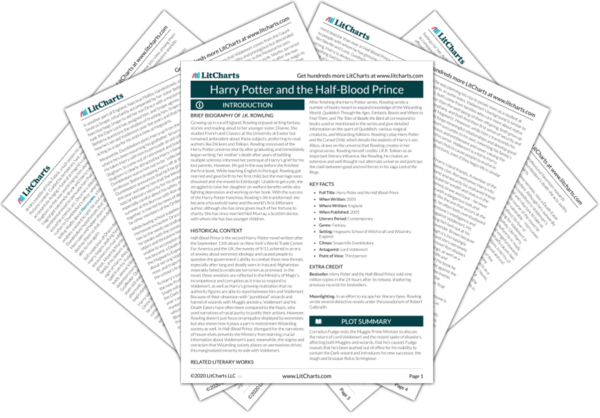Brief Biography of J. K. Rowling
Growing up in rural England, Rowling enjoyed writing fantasy stories and reading aloud to her younger sister, Dianne. She studied French and Classics at the University at Exeter but remained ambivalent about these subjects, preferring to read authors like Dickens and Tolkien. Rowling conceived of the Harry Potter universe shortly after graduating and immediately began writing; her mother’s death after years of battling multiple sclerosis informed her portrayal of Harry’s grief for his lost parents. However, life got in the way before she finished the first book. While teaching English in Portugal, Rowling got married and gave birth to her first child, but the marriage soon dissolved and she moved to Edinburgh. Unable to get a job, she struggled to raise her daughter on welfare benefits while also fighting depression and working on her book. With the success of the Harry Potter franchise, Rowling’s life transformed: she became a household name and the world’s first billionaire author, although she has since given much of her fortune to charity. She has since married Neil Murray, a Scottish doctor, with whom she has two younger children.
Historical Context of Harry Potter and the Half-Blood Prince
Half-Blood Prince is the second Harry Potter novel written after the September 11th attack on New York’s World Trade Center. For America and the UK, the events of 9/11 ushered in an era of anxiety about extremist ideology and caused people to question the government’s ability to combat these new threats, especially after long and deadly wars in Iraq and Afghanistan miserably failed to eradicate terrorism as promised. In the novel, these anxieties are reflected in the Ministry of Magic’s incompetence and corruption as it tries to respond to Voldemort, as well as Harry’s growing realization that no authority figures are able to stand between him and Voldemort. Because of their obsession with “pureblood” wizards and hatred of wizards with Muggle ancestry, Voldemort and his Death Eaters have often been compared to the Nazis, who used narratives of racial purity to justify their actions. However, Rowling doesn’t just focus on prejudice displayed by extremists but also shows how it plays a part in mainstream Wizarding society as well. In Half-Blood Prince, disregard for the narratives of house-elves prevents the Ministry from learning crucial information about Voldemort’s past; meanwhile, the stigma and ostracism that Wizarding society places on werewolves drives this marginalized minority to side with Voldemort.
Other Books Related to Harry Potter and the Half-Blood Prince
After finishing the Harry Potter series, Rowling wrote a number of books meant to expand knowledge of the Wizarding World.
Quidditch Through the Ages,
Fantastic Beasts and Where to Find Them, and
The Tales of Beedle the Bard all correspond to books used or mentioned in the series and give detailed information on the sport of Quidditch, various magical creatures, and Wizarding folklore. Rowling’s play
Harry Potter and the Cursed Child, which details the exploits of Harry’s son Albus, draws on the universe that Rowling creates in her original series. Rowling herself credits J.R.R. Tolkien as an important literary influence; like Rowling, he creates an extensive and well thought-out alternate universe and portrays the clash between good and evil forces in his saga
Lord of the Rings.
Key Facts about Harry Potter and the Half-Blood Prince
-
Full Title: Harry Potter and the Half-Blood Prince
-
When Written: 2005
-
Where Written: England
-
When Published: 2005
-
Literary Period: Contemporary
-
Genre: Fantasy
-
Setting: Hogwarts School of Witchcraft and Wizardry, England
-
Climax: Snape kills Dumbledore
-
Antagonist: Lord Voldemort
-
Point of View: Third person
Extra Credit for Harry Potter and the Half-Blood Prince
